
© 2010-2021 by Fine Arts of the Southwest, Inc. All rights reserved.
Unauthorized reproduction or use is strictly prohibited by law.
An outstanding Modernist-style silver cuff bracelet by the Navajo Arts and Crafts Guild, c.1940’s
This splendid and unique silver bracelet is very possibly the product of the great Kenneth Begay (1913-1977) in disguise, so to speak, in our opinions. More on that later after a few words of historic explanation and context.
The Navajo Arts and Crafts Guild (NACG) was created in 1941 by the Navajo tribal authority in association with the U.S. Government’s Indian Arts and Crafts Board (IACB) The co-founders of the Navajo Guild were the renowned Navajo silversmith and jewelry instructor, Ambrose Roanhorse (1904-1981) and his former student, the talented silversmith, Chester Yellowhair.
In addition to an already distinguished career as a silversmith and jewelry instructor at various New Mexico Indian Schools in Santa Fe and Fort Wingate, NM, Roanhorse had most recently served as Co-Director and Administrator of the IACB’s “U.S. Navajo” and “U.S. Zuni” jewelry inspection and quality-control program and was thus extremely well-qualified to administer a new enterprise dedicated to preserving and maintaining the quality and traditional integrity of Navajo silversmithing and jewelry-making. In his capacity as the Guild’s initial director, Roanhorse recruited, inspired and trained a veritable all-star team of the finest Navajo silversmiths of the time. To read more about the Navajo Arts and Crafts Guild, please click here.
Some of the greats who passed through the Navajo Guild’s doors were Kenneth Begay, Allan, George and Ivan Kee, and Hopi silversmith, Lewis Lomay. Others who quite possibly were involved anonymously were Austin and Kathy Wilson, Billy Goodluck, Jack Adakai and Harry Morgan. The Guild’s quality standards were extremely high and centered around the use of traditional Navajo silversmithing methods with emphasis on classic techniques, with a primary emphasis on working the silver itself with a minimum use of set stones and an elegant streamlined, Modernist design aesthetic based on purity of form and restraint in applied decoration. Roanhorse himself was the chief proponent of this clean, elegant aesthetic and it comes through clearly in his own personal work.
Ambrose Roanhorse, circa 1940’s
“It sure feel good when you wear hand-made jewelry. If they use machine jewelry, by golly, one these days 20 years from now goin’ to have big sandstorms-10 years, 8 years, maybe 5 years. That’s the way I feel. I learned to make silver from my Grandfather.”
-Ambrose Roanhorse, 1936
Quotation from Billie Hougart, “The Little Book of Marks
on Southwestern Silver”, TBR International, 2011
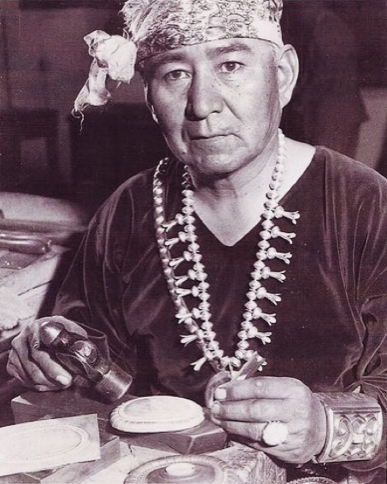
And now time for a few more words about Kenneth Begay. Begay originally apprenticed under the great Fred Peshlakai, one of the original nobility so to speak, of modern Navajo silversmithing who had in turn been taught by his Father, the legendary “Slender, Maker of Silver”. Begay’s obvious and emerging skills brought him to Roanhorse’s attention and Roanhorse brought him into the Guild’s orbit along with his first cousins, the three Kee brothers, Allan, George and Ivan. Begay was already developing his streamlined Modernist style and Roanhorse seems to have influenced him even more in that direction. This particular bracelet bears many of the hallmarks of Begay’s later distinctive work at Scottsdale’s famous White Hogan Shop in the 1950’s and 60’s; the elegant, swooping streamlined form, the mastery of the extremely difficult “hollowform” technique of making a deeper-profile and more sculpturally formed hollow bracelet that could still be light enough in weight to wear comfortably and the beautiful, spare, restrained diagonally-applied stamp work.
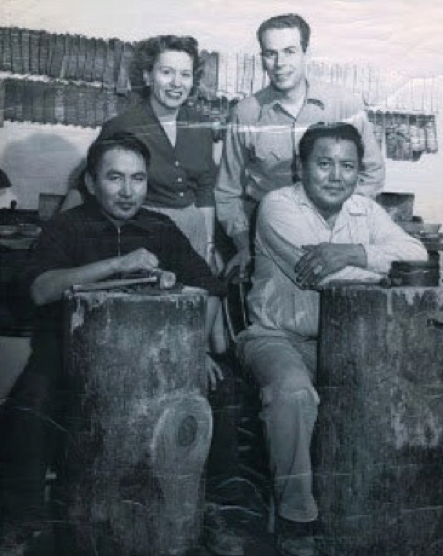
"I like to create something new and still
use the old Navajo design style.”
—Kenneth Begay
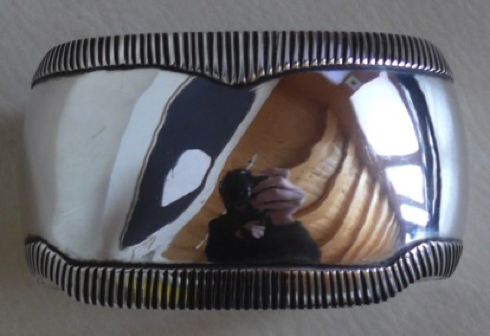
Kenneth Begay hollowform silver bracelet c. 1960‘s.
The reason we do not know definitively that Kenneth Begay made this bracelet is that this bracelet, like all Navajo Guild jewelry of this time period, is marked only with the Guild’s famous “Horned sun” hallmark and not the signature of the individual maker per the Guild’s strict regulations. It looks like a Kenneth Begay and it feels like a Kenneth Begay, so in our estimation, if it looks like a duck and quacks like a duck it probably is a duck, but for comparison purposes we have included a photograph here of another documented and signed Kenneth Begay hollowform silver cuff bracelet and we think the similarity in sensibility, construction and technique between the two is noteworthy.
The bracelet measures 1 3/16” in width at its widest points which are, interestingly, the end terminals and it tapers down to 7/8” in width at the center. It measures approximately 3/16” in thickness at the thickest points. The inner circumference end-to-end is 5 1/2” and the gap between the terminals is 1 1/8” for a total interior circumference of
6 5/8”. It weighs a very comfortable 62 grams or 2 1/8 ounces. The bracelet is properly hallmarked on the interior with the Navajo Guild’s “Horned Sun” insignia. There is also a very lightly etched-in name of what appears to be
“Mrs. F. Collins” on the interior of the bracelet, likely the name of a previous owner. The bracelet is in excellent original condition with an age-appropriate amount of minor scratches and nicks. For its 70 or so years of age it
looks stunning with a wonderful, soft patina. We should all look so good at this age.
This bracelet is a remarkably beautiful, finely-crafted and distinctive piece of historic Navajo jewelry.
Price $2,400
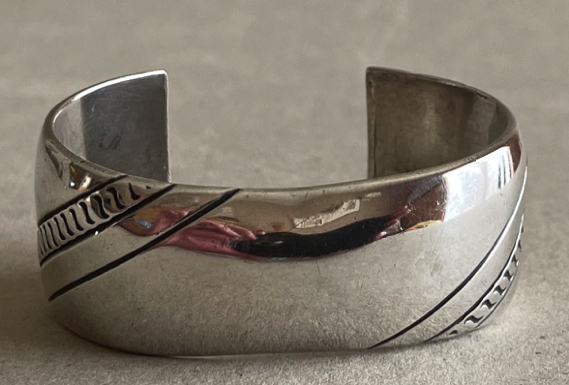
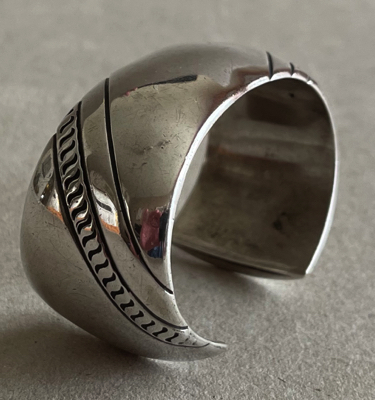
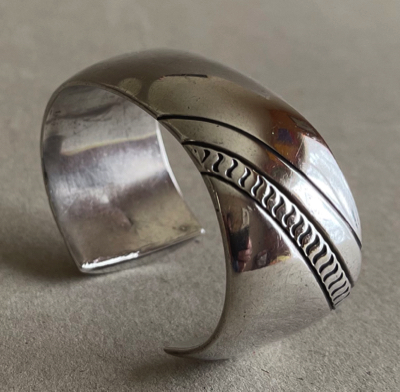
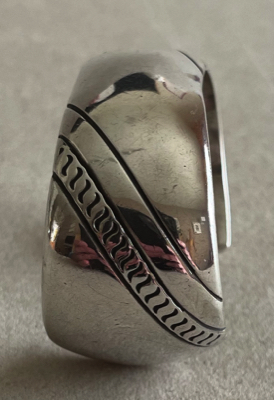
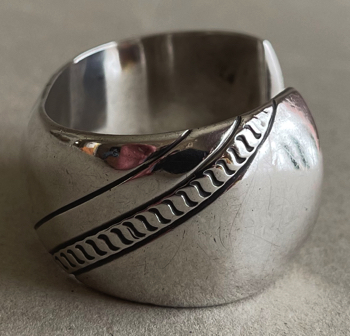
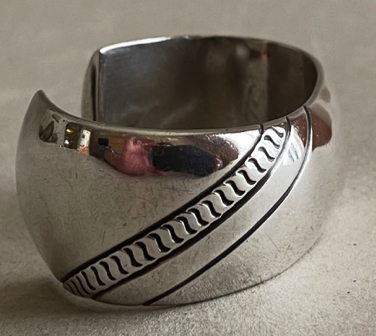
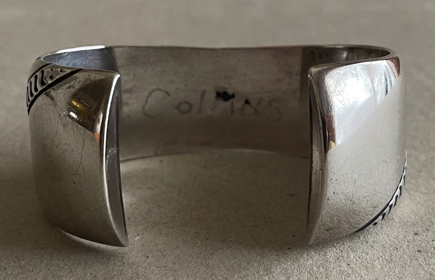
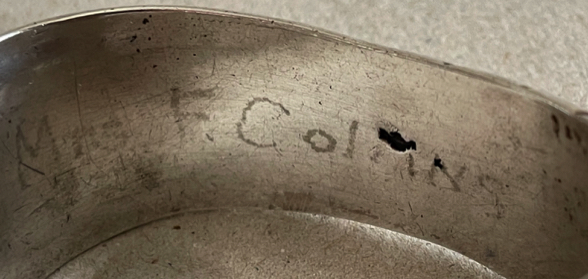
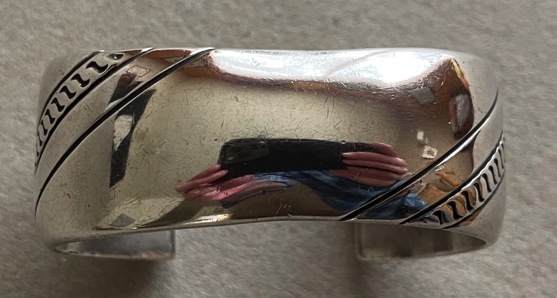
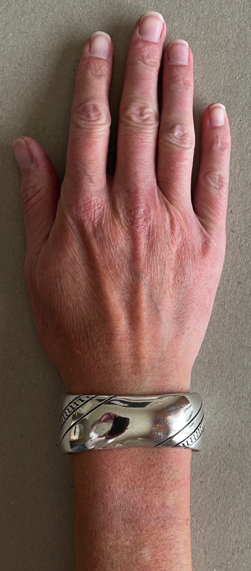
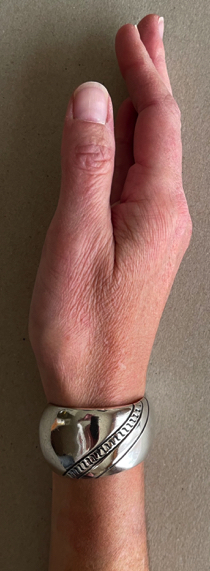
White Hogan Shop owners Virginia and John Bonnell pictured with Navajo silversmiths Allen Kee (at left) and Kenneth Begay (at right).
Photo: Arizona Republic, 1953